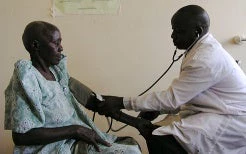Let's think together: Every Sunday the World Bank in Tanzania in collaboration with The Citizen wants to stimulate your thinking by sharing data from recent official surveys in Tanzania and ask you a few questions.
Growing old is almost a universal dream. Over the past two centuries, life expectancy in Western Europe increased from 32 (in 1800) to over 80 years in 2011. This unprecedented leap in human history came as the combination of technological advances in medicine, improved living conditions, and better nutrition, among other factors. However, old age is also often accompanied with a general deterioration in physical capacities, proneness to disease and sickness, and the inability to engage in economic activity. This heightens the risk of poverty and insecurity thereby requiring societies to find mechanisms to support their elderly population.
In line with universal trends, life expectancy in Tanzania grew from 43 in 1960 to 58 years in 2011. Today, there are roughly 2.7 million Tanzanians –the equivalent of six per cent of the total population – aged 60 and above. This rapidly expanding group is also unfortunately more vulnerable than the rest of the population. Not only are elders poorer (by about 7 per cent) but they are also more prone to disability (15.5 per cent compared to 2.4 percent for those aged between 20 and 59).
What is also striking about aging in Tanzania is that women appear significantly more vulnerable than men. Consider the following statistics:
- 56.6 per cent of elderly women are widowed compared to 7.2 per cent for males
- 19.3 per cent of elderly women claim disability compared to 10.3 per cent for males
- 17 per cent of elderly women live in one of their children’s household compared to 3 per cent for males
- 38 per cent of households headed by elderly women rely on remittances vs. 20 percent for males
- Elderly female-headed households have a 7 percent higher risk of poverty than those headed by elderly males.
Tanzania’s elderly cannot count on 'formal' social security schemes or free medical services. Approximately one out of 100 old Tanzanians was entitled to social security coverage in 2006. Only 11 per cent of them had access to healthcare fees exemption at a health facility in 2011. As a result, they have to rely on informal safety nets – mainly family to survive. Elders for instance are three times more likely than the national average to receive monetary transfers. Ultimately, the vast majority of elders have no choice but to continue to work, especially in agriculture-related activities. In 2011, 70 percent of elders (aged more than 65) were still active on the labor market in Tanzania, against 55 percent in Kenya; 30 percent in Korea and less than two percent in France.
This warrants a few questions:
- Should the welfare of the elderly be a priority for the Government given that the number of old people will increase in the years to come?
- Are traditional social safety nets (family, religious groups, friends) sufficient to protect old people?
- Should incentives be provided to families so that they are in a better position to provide support to their elderly relatives?
- To what extent should social programs target old women that on average are more vulnerable than old men?
- Is it realistic to offer access to free healthcare to all people aged 60 and over?
Note: The statistics above are based on the 2010/11 National Panel Survey, the 2006 Integrated Labor Force Survey, World Development Indicators, and ILO statistics. All are publicly available.




Join the Conversation